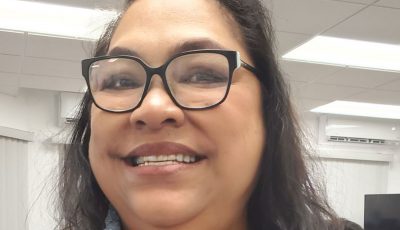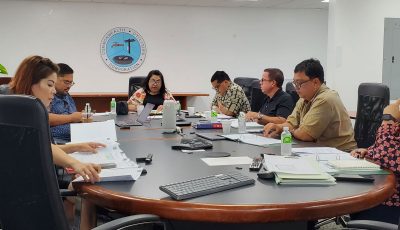PUP agreement proposed to build RO system on Saipan

A dinner meeting headed by the Office of the Lieutenant Governor on a proposed public-to-public partnership agreement to build a reverse osmosis water treatment plant on Saipan was attended by the Commonwealth Utilities Corp. and some members of the Legislature at the Fiesta Resort & Spa last night. (Frauleine Villanueva-Dizon)
A public-to-public partnership agreement with the Capital Projects Finance Authority to build a reverse osmosis water treatment plant to address Saipan’s water problems was proposed at a dinner meeting at the Fiesta Resort & Spa last night.
The meeting, initiated by the Office of the Lieutenant Governor, was attended by members of the Legislature and a quorum of board members and management of the Commonwealth Utilities Corp. and discussed the proposed reverse osmosis system to be implemented on Saipan and how it can be financed.
According to John Gonzales, chief of staff to Lt. Gov. Victor Hocog, they invited some senators and representatives for the presentation which started around 8pm. However, some representatives were not informed until around 7:30pm.
Robert Toelkes, who said he is a consultant for Hocog but is not under contract, according to Gonzales, was representing the lieutenant governor’s plan to address the water issue on Saipan, led the presentation.
Toelkes is also the president of Financial Solutions Group and International Bridge Corp., a company which filed for bankruptcy last year in the midst of its project to rebuild the John F. Kennedy High School in Guam and maintain its facilities for the next 25 years.
The Capital Projects Finance Authority or CaPFA, which was being proposed for the CNMI to enter into an agreement with, was also involved in the JFK project in Guam. CaPFA described itself as “nominal owner” of the high school.
According to its website, “CaPFA is a public body corporate and politic, created pursuant to Ordinance No. 214, duly enacted by the City Council of the City of Moore Haven, Florida on Sept. 23, 1993 for the purpose of making loans to qualified Public Agencies in the State of Florida or in the United States.”
“Capital Projects Finance Authority is a governmental entity and their goal is to assist credit challenged municipalities and that’s what they do,” Toelkes said.
In his presentation, Toelkes said that a six-million-gallon-per-day reverse osmosis water treatment plant was the immediate solution to the water problem on Saipan.
He said the RO system would be located in Lower Base adjacent to Power Plant 1 and will be housed in a precast concrete structure. The plant will include a full standby power utilizing existing rebuilt generators from Power Plant II.
The existing nine million gallon tank at Sadog Tasi would be rehabilitated and used as clear well water storage, according to Toelkes.
Toelkes said the reverse osmosis system would cost $160 million and would take 12 months to build—during which leaks and problems in the distribution need to be addressed. The cost of operation was estimated to be at $10 per a thousand gallon water.
The CUC board seemed to support the proposal, echoing Toelkes presentation that an RO system would be the immediate solution for Saipan.
However, leaks as well as problems with the aged pipes, which could later on cause contamination was raised.
Gonzales said the proposals are “options if and when the declaration is made.”
The CUC board last month requested for a declaration of emergency on the water situation on Saipan, also stating the fact that they do not have the financial capacity to address the issues. The move was seen as a possible way to circumvent the normal procurement process.
CUC board member Ignacio Perez commented that requesting for proposals on this kind of project will not give an offer like the one presented.
“This offer is a solution for power generation, reverse osmosis,” Perez said.
Asked if they will issue an RFP for such a project, CUC board chair Adelina Roberto said she has “no idea because the governor and lieutenant governor is involved now.”
“If it’s not RFP and the government gets involved, then it’s okay for CUC. That’s why CUC requested to declare a water emergency because we need the government to help us because we just don’t have the funding,” Roberto said.
With the financing proposed, CUC will not pay for five years after the system is built, according to board chair Adelina Roberto, but there is a 5 to 7 percent anticipated interest rate. CUC will pay for the project for 30 years.
When asked if she supports the proposed project, Roberto said, “We would like to go to RO system if that’s the best solution. If that’s the best solution, then we go for the best solution.”



























